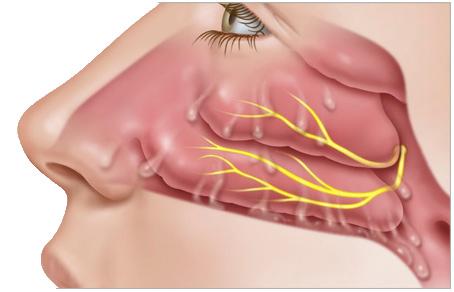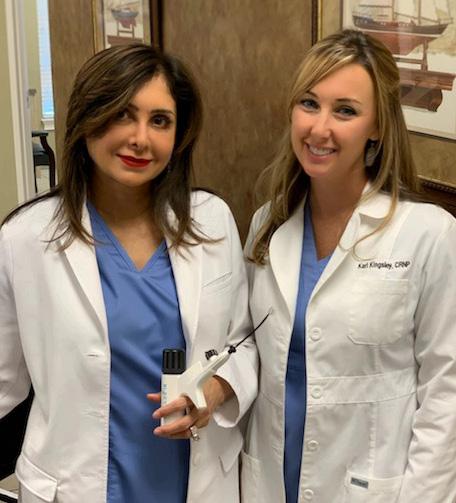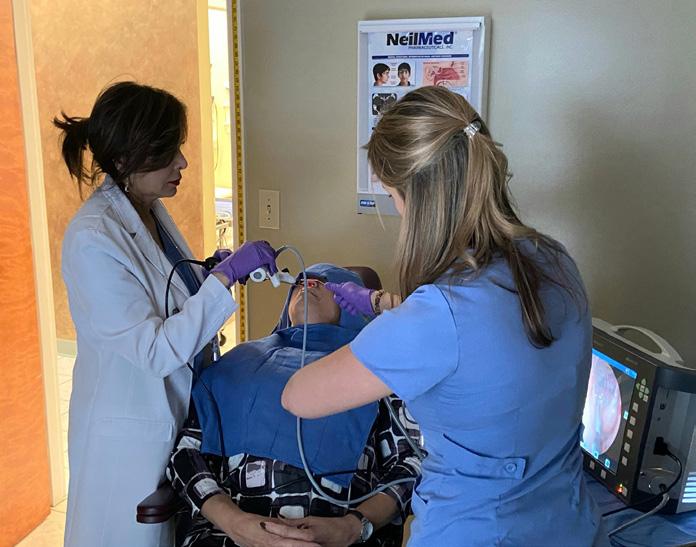
6 minute read
Defeating Drainage: A Look at the Newest Options for Combating Your Drippy Nose
By Kari Kingsley, MSN, CRNP
Drip. Drip. Sniff. Sniff. Most of us are familiar with the neverending cycle of sinus drainage that is associated with living in the Tennessee Valley. Having worked in the Ear, Nose, and Throat field in Huntsville for the past 11 years, I’ve come across many patients that say Native Americans called our area the “Valley of Death”. While most of us aren’t dying from sinus drainage, we are seriously annoyed.
Drainage falls into two categories: allergic and non-allergic rhinitis. Spring is beautiful in the South. Blooming dogwoods, hikes on the Land Trust, and Panoply are just a few of the things that make our area unique. Not so unique, but still a major part of Spring in our area, is the overabundance of pollen. Lots of pollen. Patients call it Sneezing Season. My black car becomes a Horse of a Different Color with streaks of yellow pollen rainbows across the windshield. Summer is warm in the South. Most of us enjoy watermelon, fireworks, and sunny days by the pool. But allergy sufferers don’t enjoy the ever-green and ever-growing grass. I learned long ago that it was worth outsourcing my grass-cutting to a professional. After the boxes of Kleenex, Zyrtec, and Sudafed, I basically break even. Fall in Alabama has a vibe unlike any other. Dazzling foliage, football, and the crisp night air seem like an almost fair trade for newly sprayed cotton fields, ragweed, and leaf mold. While the winter months bring holiday cheer and moderate temperatures, they also bring indoor heat, fireplaces, and damp outside environments to further irritate already cranky noses.

NORMAL NASAL CAVITY
Nasal nerves help regulate the nasal activity

CHRONIC RHINITIS
Out-of-balance nasal nerves may send too many signals, contributing to congestion and runny nose symptoms

CLARIFIX CYROTHERAPY
Nerve signals are interrupted to reduce congestion and runny nose symptoms
When you Google best places to live for sinus sufferers it is no surprise that saline misted beach towns in Florida and California dominate most lists. Each summer, I have patients tell me that their sinuses did ‘great’ while they vacationed on the beach. Their drippy nose returned once they were home. While the beach is a great place to visit, North Alabama is my home. And I want my home to be as comfortable as possible. Anything to reduce the drip and sniff is well appreciated.
The Allergy and Asthma Foundation of America’s 2019 National Spring Rankings list of most challenging places to live with allergies looks at the 100 most populated metropolitan areas. A number is assigned based on the seasonal pollen, allergy medication use, and the number of allergy specialists. Huntsville isn’t includedon this list. It’s possible with our size, we didn’t make the cut. Obviously, they haven’t read the latest census that we’re on track to be the largest Alabama city by 2022. Birmingham came in at # 33. Our neighbors in Jackson, Mississippi came in 2nd place and Memphis came in 4th. There is another section of the population that suffers from nonallergic rhinitis or sinus drainage that is not related to allergies. Triggers of nonallergic rhinitis include environmental irritants, foods and beverages, hormone fluctuations, sleep apnea, and reflux. While some think overly fragrant perfumes are attractive and pleasant, there are an equal number of people in the population that would prefer you not take a Chanel Shower. For others, the simple trade-off of a comforting warm bowl of soup on a cold winter day isn’t worth the nasal faucet that ensues.
Just as our cars require oil to run properly, mucus is a normal biological lubricant that plays an important role in our health, protecting us from fungi, viruses, and bacteria. We have all heard the expression too much of a good thing... Overproduction of nasal mucus triggered by allergies, upper respiratory infections, as well as dry and cold environments can initiate a myriad of annoying symptoms. Excessive mucus accumulates in the back of the nasal cavity and eventually begins dripping down the back of the throat, causing an aggravating cough sure to solicit sharp glances from those in closest proximity.
In our evolving instant-gratification-society and Amazon delivered it yesterday world, it’s only natural we want a quick and easy fix to one of the most annoying nasal issues. What are our treatment options? Staying hydrated is important. You are, after all, producing about a liter and a half of mucus a day. (Ew; I cringed when I first read those stats). Avoid alcohol, caffeine, and cigarettes as these things tend to exacerbate sinus and allergy issues. Saline irrigations and sprays help lubricate irritated nasal passageways. Over the counter antihistamines, decongestants, steroid-based nasal sprays, as well as prescription anticholinergics and leukotriene modifiers work by blockingmucus production or by drying existing mucus. While these treatments can manage the symptoms of a runny nose and postnasal drip, oftentimes they are not enough and are required daily in most cases. They also have multiple side effects. Avoidance of environmental triggers is also important. As a pet-mom to a horse, a dog, 2 cats, and 6 chickens, that isn’t always feasible. Allergy shots or immunotherapy is an option for some but can be pricey, depending upon insurance coverage. They also include a hefty time commitment.
So, what other options are there? One of the newest innovations to sinus health is intranasal cryotherapy. The exact cause of chronic rhinitis is unknown. It is thought to be related to overactive nasal nerves, specifically the parasympathetic posterior nasal nerve. Cryotherapy applied in the nose offers a minimally-invasive approach that interrupts the signals from these nerves to decrease nasal drainage. ClariFix® cryotherapy is the first and only FDA approved medical device used to treat chronic rhinitis in adults.
How does it work? Intranasal cryotherapy uses a state-ofthe-art wand that applied nitrous oxide cryogen through a small balloon tip to freeze nerve fibers at the back of the the nose that contribute to excessive mucus production. Downtime is minimal. Side effects are mild and include temporary headache and congestion, usually for a day. Approximately 80% of patients notice a significant reduction in nasal drainage within the first 3 to 6 weeks.

Dr. Neeta Kohli-Dang and Kari Kingsley, MSN, CRNP share nearly forty years of ENT experience. Please visit Kari and Dr. Dang at their practice website: huntsvilleearnosethroat.com or call (256) 882-0165 to schedule an appointment.
Dr. Neeta Kohli-Dang (whom I lovingly call, Boss) has done more cryoablations than any other physician in the Southeast. She says, “We have the procedure down to a fine art.” Topical anesthetics are used in the nose and then a cooling probe is applied which takes less than a minute. Patients enjoy a latte or coffee and then go home. Start to finish, the entire appointment can last less than an hour, most of which is spent numbing the nasal cavity. For some, the option of snorting medications every day may not be the best option. If you are tired of the constant drip and sniff, consider intranasal cryotherapy for a more permanent solution.

Dr. Neeta Kohli Dang performing minimally invasive in-office cryotherapy to improve a patient’s nasal drainage.
Kari Kingsley, MSN, CRNP is an otolaryngology nurse practitioner with over 8 years of ENT experience who currently works at Huntsville ENT (256-882-0165). She is a medical writing consultant for Inside Medicine and enjoys writing articles on pertinent material to keep the residents of North Alabama up to date on the forefront of medicine.










